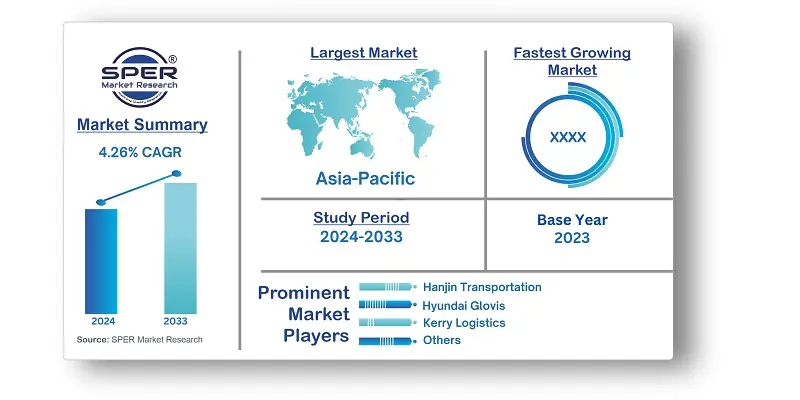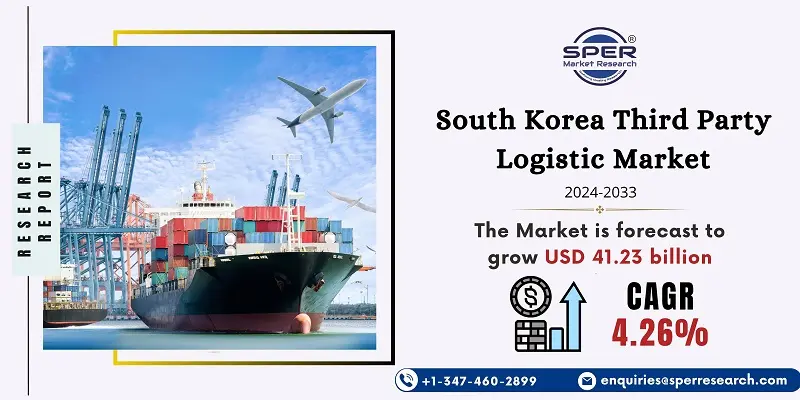
South Korea Third Party Logistic Market Growth, Size, Trends, Share, Demand and Future Outlook
South Korea Third Party Logistic (3PL) Market Size- By Service, By Distributive trade, By End User- Regional Outlook, Competitive Strategies and Segment Forecast to 2033
| Published: Jul-2024 | Report ID: AMIN24175 | Pages: 1 - 109 | Formats*: |
| Category : Automotive & Transportation | |||
- November 2022: Gymshark and DSV agreed into a strategic alliance so that Gymshark could satisfy the demands of its customers, complex supply chain requirements, and expanding international sales. Gymshark, a British fitness community and apparel brand, has designated DSV as an official logistics and transport partner. DSV will be instrumental in helping the firm achieve its ambitious expansion plan. In this role, DSV will offer Gymshark's fitness gear, clothes, and accessories worldwide multimodal transportation options.
- August 2022: Daewoo Logistics opened a container yard that can handle 3,580 TEU per day and serves Busan New Port. The yard opened on August 24. South Gyeongsam province's Jinhae district in Changwon is home to the 45,608-square-meter complex. Northeast Asia's centre for logistics is the Busan-Jinhae Economic Free Economic Zone.


| Report Metric | Details |
| Market size available for years | 2020-2033 |
| Base year considered | 2023 |
| Forecast period | 2024-2033 |
| Segments covered | By Service, By Distributive trade, By End-User |
| Regions covered | Seoul Metropolitan Areas (Seoul-Incheon-Gyeonggi), Busan, Daegu-Gyeongbuk Region, Gwangju-Jeolla Region, Daejeon-Chungcheong Region, Gangwon Province, Rest of South Korea |
| Companies Covered | CJ Logistics, DHL Korea, Hanjin Transportation, Hyundai Glovis, Kerry Logistics, Korea Express, Kuehne & Nagel Korea, LG CNS, Pantos Logistics, Samsung SDS, Others. |
- Retailers
- Manufacturer
- E-commerce Companies
- Importers and Exporters
- Automotive Companies
- Pharmaceuticals and Healthcare Providers
- Consumer Goods Companies
| By Service: |
|
| By Distributive Trade: |
|
| By End-Users: |
|
- South Korea Third Party Logistic Market Size (FY’2024-FY’2033)
- Overview of South Korea Third Party Logistic Market
- Segmentation of South Korea Third Party Logistic Market By Service (Domestic Transportation Management, International Transportation Management, Value-Added Warehousing and Distribution)
- Segmentation of South Korea Third Party Logistic Market By Distributive Trade (Wholesale, Retail Trade, E-Commerce)
- Segmentation of South Korea Third Party Logistic Market By End Users (Manufacturing and Automotive Oil & Gas and Chemicals)
- Statistical Snap of South Korea Third Party Logistic Market
- Expansion Analysis of South Korea Third Party Logistic Market
- Problems and Obstacles in South Korea Third Party Logistic Market
- Competitive Landscape in the South Korea Third Party Logistic Market
- Impact of COVID-19 and Demonetization on South Korea Third Party Logistic Market
- Details on Current Investment in South Korea Third Party Logistic Market
- Competitive Analysis of South Korea Third Party Logistic Market
- Prominent Players in the South Korea Third Party Logistic Market
- SWOT Analysis of South Korea Third Party Logistic Market
- South Korea Third Party Logistic Market Future Outlook and Projections (FY’2024-FY’2033)
- Recommendations from Analyst
1.1. Scope of the report1.2. Market segment analysis
2.1. Research data source
2.1.1. Secondary Data2.1.2. Primary Data2.1.3. SPER’s internal database2.1.4. Premium insight from KOL’s
2.2. Market size estimation
2.2.1. Top-down and Bottom-up approach
2.3. Data triangulation
4.1. Driver, Restraint, Opportunity and Challenges analysis
4.1.1. Drivers4.1.2. Restraints4.1.3. Opportunities4.1.4. Challenges
4.2. COVID-19 Impacts of the South Korea Third Party Logistic Market.
5.1. SWOT Analysis
5.1.1. Strengths5.1.2. Weaknesses5.1.3. Opportunities5.1.4. Threats
5.2. PESTEL Analysis
5.2.1. Political Landscape5.2.2. Economic Landscape5.2.3. Social Landscape5.2.4. Technological Landscape5.2.5. Environmental Landscape5.2.6. Legal Landscape
5.3. PORTER’s Five Forces
5.3.1. Bargaining power of suppliers5.3.2. Bargaining power of buyers5.3.3. Threat of Substitute5.3.4. Threat of new entrant5.3.5. Competitive rivalry
5.4. Heat Map Analysis
6.1. South Korea Third Party Logistic Market Manufacturing Base Distribution, Sales Area, Product Type6.2. Mergers & Acquisitions, Partnerships, Product Launch, and Collaboration in South Korea Third Party Logistic Market
7.1. South Korea Third Party Logistic Market Size, Share and Forecast, By Service, 2020-20267.2. South Korea Third Party Logistic Market Size, Share and Forecast, By Service, 2027-20337.3. Domestic Transportation Management7.4. International Transportation Management7.5. Value-Added Warehousing and Distribution
8.1. South Korea Third Party Logistic Market Size, Share and Forecast, By Distributive Trade, 2020-20268.2. South Korea Third Party Logistic Market Size, Share and Forecast, By Distributive Trade, 2027-20338.3. Wholesale8.4. Retail Trade8.5. E-Commerce
9.1. South Korea Third Party Logistic Market Size, Share and Forecast, By End-Users, 2020-20269.2. South Korea Third Party Logistic Market Size, Share and Forecast, By End-Users, 2027-20339.3. Manufacturing and Automotive9.4. Oil & Gas and Chemicals
10.1. South Korea Third Party Logistic Market Size and Market Share
11.1. South Korea Third Party Logistic Market Size and Market Share By Region (2020-2026)11.2. South Korea Third Party Logistic Market Size and Market Share By Region (2027-2033)
11.2.1. Seoul Metropolitan Areas (Seoul-Incheon-Gyeonggi)11.2.2. Busan11.2.3. Daegu-Gyeongbuk Region11.2.4. Gwangju-Jeolla Region11.2.5. Daejeon-Chungcheong Region11.2.6. Gangwon Province11.2.7. Rest of South Korea
12.1. CJ Logistics
12.1.1. Company details12.1.2. Financial outlook12.1.3. Product summary12.1.4. Recent developments
12.2. DHL Korea
12.2.1. Company details12.2.2. Financial outlook12.2.3. Product summary12.2.4. Recent developments
12.3. Hanjin Transportation
12.3.1. Company details12.3.2. Financial outlook12.3.3. Product summary12.3.4. Recent developments
12.4. Hyundai Glovis
12.4.1. Company details12.4.2. Financial outlook12.4.3. Product summary12.4.4. Recent developments
12.5. Kerry Logistics
12.5.1. Company details12.5.2. Financial outlook12.5.3. Product summary12.5.4. Recent developments
12.6. Korea Express
12.6.1. Company details12.6.2. Financial outlook12.6.3. Product summary12.6.4. Recent developments
12.7. Kuehne & Nagel Korea
12.7.1. Company details12.7.2. Financial outlook12.7.3. Product summary12.7.4. Recent developments
12.8. LG CNS
12.8.1. Company details12.8.2. Financial outlook12.8.3. Product summary12.8.4. Recent developments
12.9. Pantos Logistics
12.9.1. Company details12.9.2. Financial outlook12.9.3. Product summary12.9.4. Recent developments
12.10. Samsung SDS
12.10.1. Company details12.10.2. Financial outlook12.10.3. Product summary12.10.4. Recent developments
12.11. Others
SPER Market Research’s methodology uses great emphasis on primary research to ensure that the market intelligence insights are up to date, reliable and accurate. Primary interviews are done with players involved in each phase of a supply chain to analyze the market forecasting. The secondary research method is used to help you fully understand how the future markets and the spending patterns look likes.
The report is based on in-depth qualitative and quantitative analysis of the Product Market. The quantitative analysis involves the application of various projection and sampling techniques. The qualitative analysis involves primary interviews, surveys, and vendor briefings. The data gathered as a result of these processes are validated through experts opinion. Our research methodology entails an ideal mixture of primary and secondary initiatives.



Frequently Asked Questions About This Report
PLACE AN ORDER
Year End Discount
Sample Report
Pre-Purchase Inquiry
NEED CUSTOMIZATION?
Request CustomizationCALL OR EMAIL US
100% Secure Payment






Related Reports
Our Global Clients
Our data-driven insights have influenced the strategy of 200+ reputed companies across the globe.






















